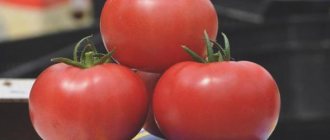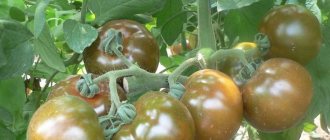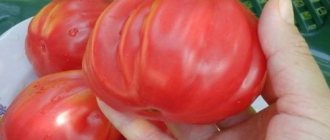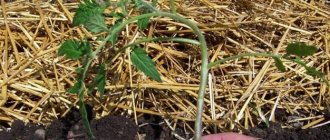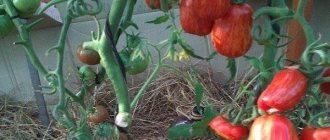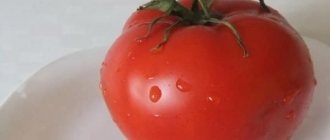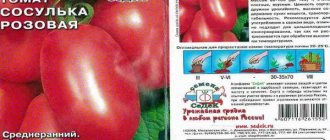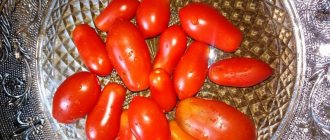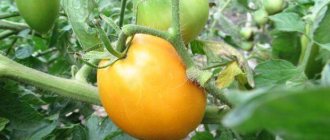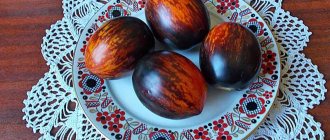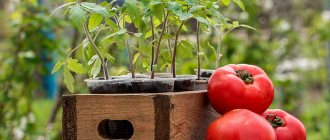Until recently, when everyone heard about a banana, everyone thought only about the fruit. And today all gardeners know about the famous tomato of the same name. The variety is intended for mid-latitudes and is very popular for its simplicity of agricultural technology.
| Height | Landing location | Ripening time | Fruit color | Fruit size | Origin | Fruit shape |
| Medium height | Greenhouse, Open ground | Early ripening | Reds | Average | Variety | Plum-shaped or oval |
Tomatoes Banana Yellow: variety description
The Yellow Banana tomato is not a hybrid; it is a variety of amateur selection and has many excellent qualities.
Yellow banana is an indeterminate plant, a strong stem with several tassels, multi-leaved, reaches a height of 3 m. It is not a standard bush. When fruits form, the plant should be pinched at the growing point - all the nutrients will go into the fruits. The rhizome develops vigorously, in a permanent place - more than 50 cm in width, without deepening. The leaves are of medium size, interesting openwork shape, light green, wrinkled, without pubescence. The inflorescence is simple, intermediate - every 2 leaves, the first time is laid after the 7th leaf. An inflorescence with many flowers, fruits can be from 10 pieces. The peduncle is strong, the fruits stick tenaciously to the plant and do not fall off. According to the degree of ripening, it is a medium-late variety, the period from planting seeds to harvesting is about 125 days.
High resistance to “tobacco mosaic” was noted, and also has good resistance to other major diseases. Growing is permissible in greenhouses and open ground (with the exception of the northern regions).
Care
The Siberian banana tomato, in terms of characteristics, description, and agricultural technology, differs little from other varieties bred for harsh conditions:
- stepsons are removed once every two weeks;
- the lower leaves, when the first cluster appears and begins to fill, are gradually removed;
- overgrown stepsons are not removed, but are pinched;
- the plant is formed into two trunks and must be tied up, for which trellises are suitable.
Caring for tomatoes Siberian bananas
The bushes are fed for the first time two weeks after planting. To protect against pest attacks and replenish potassium, plants are sprinkled with clean wood ash.
When the fruits begin to ripen, you need to re-enrich the soil with potassium. Foliar feeding is planned in the morning, when the sun has not risen high.
Under standard conditions, mulching the soil is necessary to retain moisture. If the summer was rainy, the procedure will not be required.
Characteristics
The shape of the fruit is elongated with a small nose, plum-shaped, sometimes curved, the fruits look like small bananas (hence the name). The sizes are small, on average 7 cm long, weighing about 120 g . The skin is dense, smooth, thin. The color of unripe fruits is light green, mature ones are warm yellow. Meaty, not dry. There are few seeds, distributed evenly across two chambers. The amount of dry matter is average.
You can compare the weight of the fruits of this variety with others in the table below:
| Variety name | Fruit weight |
| Yellow banana | 120 grams |
| The president | 250-300 grams |
| Summer resident | 55-110 grams |
| Broody | 90-150 grams |
| Andromeda | 70-300 grams |
| Pink Lady | 230-280 grams |
| Gulliver | 200-800 grams |
| Banana red | 70 grams |
| Nastenka | 150-200 grams |
| Olya-la | 150-180 grams |
| De Barao | 70-90 grams |
Tomato variety Banana yellow - Russian amateur selection . The originator is Agrofirm Poisk LLC. Included in the State Register of the Russian Federation for cultivation in greenhouse conditions in 2015. It is permissible to grow throughout the Russian Federation in film, glazed greenhouses. In open ground, the yield may be lower; planting is favorable in the southern regions.
They have amazing taste and contain many vitamins. Sweet, aromatic. It is considered a salad variety . Suitable for fresh consumption, in sandwiches, salads, and hot dishes. Small size and elongated shape are suitable for canning whole fruits; they do not crack during heat treatment. The production of tomato paste and juice is relevant, the color will be the highlight. It has a good yield, about 7 kg per 1 sq.m., from 3 kg per plant .
You can see the yields of other tomato varieties in the table below:
| Variety name | Productivity |
| Yellow banana | 7 kg per square meter |
| Russian size | 7-8 kg per square meter |
| Long Keeper | 4-6 kg per bush |
| Podsinsky miracle | 5-6 kg per square meter |
| American ribbed | 5.5 kg per bush |
| De Barao the giant | 20-22 kg per bush |
| Premier | 6-9 kg per square meter |
| Polbig | 4 kg per bush |
| Black bunch | 6 kg per bush |
| Kostroma | 4-5 kg per bush |
| Red bunch | 10 kg per bush |
How to grow tomatoes
For a good harvest, it is necessary to follow basic agrotechnical rules.
Landing
It is better to prepare the soil in the fall. It is necessary to dig up the soil and add fertilizers to it, for example, a mixture of compost and superphosphate. In the spring, it is recommended to fertilize the area with potash fertilizers. Red bananas are planted after all frosts have passed.
Important! The roots should be carefully pressed with earth on all sides. After planting, the sprouts need abundant watering.
Every 10-12 days the soil needs to be loosened.
This simple operation saturates the soil with oxygen and makes it more airy. In addition to loosening, tomatoes need regular and timely watering. Remember to avoid getting water on the leaves and stems. The best time for watering is the second half of the day and cloudy weather. Watering is also required before applying mineral fertilizers and before loosening the soil. Throughout the entire growing period, the “banana” tomato is fertilized with organic and mineral fertilizers. The first feeding is necessary 15 days after planting. Mullein solution, ammonium nitrate or potassium salt are suitable for this.
It is also important not to forget about pinching and tying up bushes. Form a bush into one stem, leaving 2-3 brushes. The plant is planted every 10 days. Stepchildren should be removed carefully, without harming the main stem.
Features of cultivation and possible difficulties
It is best to tie the Red Banana to ordinary wooden pegs. They are placed to the left of the stem at a distance of 10 cm. The bushes are attached with pegs in several stages. The first - immediately after planting the vegetable, and the second and third - as the plant develops.
Photo
See below: Banana tomatoes photo
Farmer reviews
Let's see what experienced farmers and novice gardeners say about the Red Banana variety.
Anastasia, Barnaul: “I planted many varieties on my plot, but Red Banana turned out to be the most fruitful for me. I enjoy using beautiful, neat tomatoes in salads and canning. I grow tomatoes in a greenhouse, I’m very happy.”
Larisa, Volgograd: “I constantly grow the variety in open beds. I'm in no hurry to harvest. Red banana, in my opinion, is inferior in taste to some other popular tomatoes. Therefore, it is best to use the variety in pickled or dried form, and for salads use other tomatoes that are richer in taste.”
Valentina, Zlatoust: “I planted this variety for the first time. I won't say that he surprised me very much. It tastes ordinary, and what’s more, you need to carefully care for the bushes. The beds quickly become overgrown with weeds, so it takes a lot of time to care for them.”
Features of cultivation
The foliage and fruit of the plant are of unusual shape. Due to the dense consistency of the fruit, storage is excellent and long . Transportation is carried out without consequences. Tomatoes are stored in a dark, dry place. Seedlings are planted in early February. The soil for planting is steamed and disinfected. Seeds are disinfected in special solutions.
A weak solution of potassium permanganate is suitable for disinfection. Plant at a depth of 2 cm, the distance between plants is about 2 cm. Cover with polyethylene for the required humidity. After germination, remove the polyethylene. The optimal temperature for seedling growth is 25 degrees. Illumination with fluorescent lamps is required. Picking when the first leaf is formed. In the second half of April-May, they can be planted in a greenhouse. The soil should be well loosened and dug with humus.
Plant in holes with a distance of 50-70 cm. Water at the root abundantly, not often. A well-lit place is required. Pruning is necessary, the formation of a bush with 2 stems. Tying immediately after planting to vertical trellises . Feed every 1.5 weeks.
We bring to your attention articles about high-yielding and disease-resistant tomato varieties. And also about tomatoes that are resistant to late blight and about effective methods of protection against this disease.
Diseases and pests
Tomato Banana is resistant to most fungal and viral diseases. However, given the late ripening of the variety, in the second half of summer, experienced vegetable growers recommend carrying out 2 preventive treatments. Copper sulfate, the drug Fitosporin, and folk remedies like sour milk with iodine are suitable.
Pests are rare guests on tomato leaves. They are repelled by the strong smell. A mole cricket can settle in the roots. To avoid pest invasion, the beds are kept clean and the soil is regularly loosened. When insects appear that can destroy a large number of bushes, the soil is treated with special preparations.
